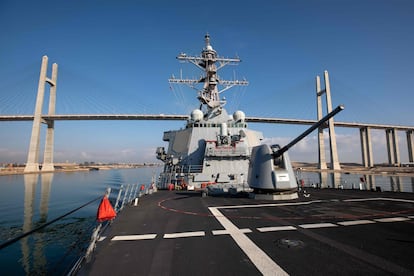Attacks on Houthi militia targets in Yemen bring the Red Sea region closer to the abyss
In addition to the war in Gaza, other flashpoints in this strategic area include piracy, the conflict in Sudan and territorial disputes between Ethiopia, Somalia and Somaliland

Tension and uncertainty in the Red Sea and Horn of Africa regions are growing rapidly as a combination of military movements, threats to global maritime trade, territorial disputes, diplomatic maneuvers and humanitarian crises are edging this small but precious strategic space ever closer to the abyss. The risk of escalation has increased significantly after the United States and the United Kingdom attacked Houthi rebel targets in Yemen early Friday morning by sea and air in an attempt to reduce their military capabilities, according to Washington. Since December, the U.S. has been leading an international naval force deployed in the southern Red Sea. The Yemeni fundamentalist militia has been threatening the ships transiting these waters with around 12% of the world’s trade through the Suez Canal since November.
This military response hit 60 Yemeni rebel targets, including the strategic port of Hodeida. It comes after the Iranian-backed Yemeni movement— which controls 30% of the country’s territory, including the capital Sana’a — launched its biggest attack on ships in the Red Sea to date on Tuesday. Days earlier, a naval coalition of the US, the UK and a dozen other allies, dubbed the Guardian of Prosperity, declared that it would hold the Houthis responsible for continuing to disrupt maritime traffic in these waters.
Since mid-November, the Houthi movement has been attacking merchant ships allegedly linked to Israel, sometimes wrongly, in response to the devastating Israeli offensive in Gaza. These activities have prompted the world’s largest shipping companies to avoid these waters, even if it means circumnavigating Africa, which makes freight rates 170% more expensive.
According to the U.S. Central Command (Centcom), the Houthis have carried out 27 attacks so far. The impact on maritime traffic is clear: the average number of ships crossing the Bab el Mandeb — the strait through which the Red Sea is accessed — fell by 45% each week compared to a year earlier and by 28% in the Suez Canal, according to the maritime trade monitoring platform PortWatch. Traffic at the Cape of Good Hope in South Africa rose by 63% in the same period.
The attack on Houthi targets in Yemen came a day after Iran captured an oil tanker in the nearby Gulf of Oman; it has already provoked the first reactions in the region. Saudi Arabia — which has been negotiating a definitive ceasefire for months with the Houthi militia, its enemy in Yemen’s nine-year war — has called for restraint and “avoiding escalation.” The rebels’ response was launching a barrage of cruise and ballistic missiles against U.S. and U.K. warships in the Red Sea, EfE reported, citing militia sources.
Pirates
In addition to these attacks on Yemeni militia ships, piracy is also a threat in nearby waters. On January 4, an organization associated with the British Royal Navy said that it had received a report of a pirate attack on a merchant ship that was sailing off the coast of Somalia, which led a contingent of the Indian Navy to intervene.
An official from the International Maritime Bureau of the International Chamber of Commerce in London informed EL PAÍS by e-mail of another similar incident in mid-December. Prior to those two episodes, the last attack by pirates occurred in 2018. Some analysts believe that the diversion of shipping traffic to those waters could be encouraging an uptick in piracy incidents because of the Houthi threat, and the increased military attention the Red Sea is now receiving.
Across the Horn of Africa, on the southern shore of the Red Sea, internal tension has also increased following the January 2 signing of a preliminary agreement between Ethiopia, the world’s most populous landlocked country, and Somaliland, a self-proclaimed republic northwest of Somalia, from which the former gained de facto independence in 1991. Since then, this territory has remained stable, but it has not been recognized internationally.
Pending ratification, the agreement grants Ethiopia an outlet and commercial and military access to the strategic Gulf of Aden, which connects to the Red Sea through the Bab el Mandeb strait, through the territory of Somaliland, in exchange for recognizing its independence. This commitment has triggered tensions between Ethiopia and Somalia; the federal government of the latter has branded the pact unauthorized, null and void and an act of aggression to which it reserves the right to respond. The Somali government, which is currently engaged in a war against the Al Qaeda-affiliated Al Shabab insurgency, has announced the withdrawal of its ambassador to Ethiopia.
Egypt and Eritrea have also criticized the agreement. The two countries have strained relations with Ethiopia and are wary of its ambitions in the Red Sea. Djibouti, whose ports now channel more than 95% of Ethiopia’s imports and exports in return for lucrative fees, has demanded respect for Somalia’s sovereignty, as have the United States, the European Union and the Arab League. Ethiopia lost access to the coastline after Eritrea’s secession in 1993 following its war of independence.
“Countries in the region have begun to align around this crisis, with Somalia calling for support from Egypt and Eritrea. Given the history of proxy wars in the Horn of Africa, there is a considerable chance of this conflict spilling over into a regional confrontation,” says Samira Gaid, a regional analyst at the Balqiis consultancy in Mogadishu, the Somali capital.
The war in Sudan
The proliferation of regional crises also includes neighboring Sudan, which has been engulfed in a war between the regular army and the paramilitary Rapid Support Forces since April. After taking control of almost all of western Darfur and the capital Khartoum, the paramilitaries seized a key province in the center of the country in December, putting them in an advantageous position to decide whether to push eastward toward the coast.
If they choose to move in that direction, given the large mobilization of armed groups and civilians fearful of paramilitaries, many fear that the conflict could degenerate into a more atomized all-out war, risking Sudan turning into a failed state. The most cautious estimates already put the death toll at 12,000 at least, and the country is experiencing the world’s worst displacement crisis, with over 7 million people displaced.
In recent weeks, paramilitary commander Mohamed Hamdan Dagalo has embarked on an unusual diplomatic tour, during which he has met with heads of state and government in Uganda, Djibouti, Ethiopia, Kenya, South Africa and Rwanda. Many suspect the trip was sponsored by the United Arab Emirates.
“I don’t think there’s anything in the Horn of Africa that can’t be managed through diplomatic channels, but the problem is that no one is doing it,” notes Cameron Hudson, an expert on Africa at the Center for Strategic and International Studies. “There is a lot of room for diplomacy, but there is no diplomacy in the region,” he observes.
Sign up for our weekly newsletter to get more English-language news coverage from EL PAÍS USA Edition
Tu suscripción se está usando en otro dispositivo
¿Quieres añadir otro usuario a tu suscripción?
Si continúas leyendo en este dispositivo, no se podrá leer en el otro.
FlechaTu suscripción se está usando en otro dispositivo y solo puedes acceder a EL PAÍS desde un dispositivo a la vez.
Si quieres compartir tu cuenta, cambia tu suscripción a la modalidad Premium, así podrás añadir otro usuario. Cada uno accederá con su propia cuenta de email, lo que os permitirá personalizar vuestra experiencia en EL PAÍS.
¿Tienes una suscripción de empresa? Accede aquí para contratar más cuentas.
En el caso de no saber quién está usando tu cuenta, te recomendamos cambiar tu contraseña aquí.
Si decides continuar compartiendo tu cuenta, este mensaje se mostrará en tu dispositivo y en el de la otra persona que está usando tu cuenta de forma indefinida, afectando a tu experiencia de lectura. Puedes consultar aquí los términos y condiciones de la suscripción digital.
More information
Archived In
Últimas noticias
Welcome to the post-religion era: The idea of Christianity as the absolute truth has become obsolete
‘I thought you would like it’: The risky sexual practice popularized by TV shows and TikTok
The digitalization of tourism: ‘They promise experiences and gave us the worst possible one’
Mexican peso defies uncertainty with forecasts of a new period of stability in 2026
Most viewed
- Sinaloa Cartel war is taking its toll on Los Chapitos
- Oona Chaplin: ‘I told James Cameron that I was living in a treehouse and starting a permaculture project with a friend’
- Reinhard Genzel, Nobel laureate in physics: ‘One-minute videos will never give you the truth’
- Why the price of coffee has skyrocketed: from Brazilian plantations to specialty coffee houses
- Silver prices are going crazy: This is what’s fueling the rally











































